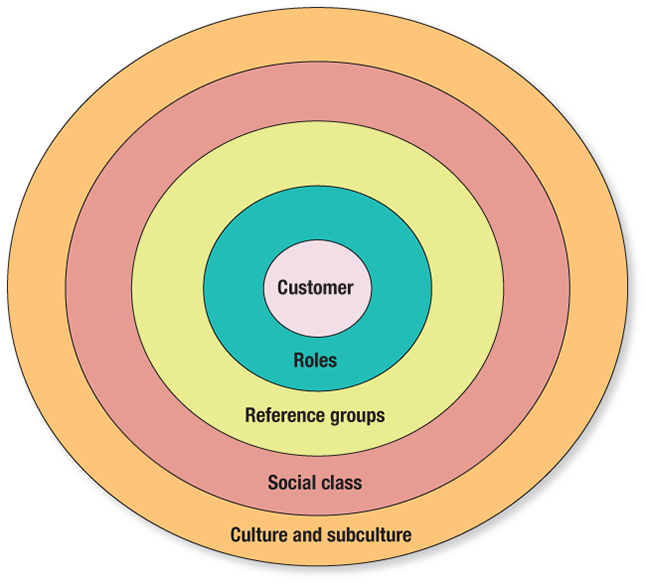Group Influences That Affect Buying Decisions
As noted earlier, the people around us also influence our buying decisions. These group influences can be grouped into four major areas: (1) roles, (2) reference groups, (3) social class, and (4) culture and subculture.37 (See Figure 8.7.) Salespeople who understand these roles and influences can develop the type of insight customers view as being valuable.

Figure 8.7 Group Influences That Influence Buying Decisions Model
To gain additional insights into customers’ motivations, it is helpful to study the group influences that affect buying decisions.
Role Influence
Throughout our lives, we occupy positions within groups, organizations, and institutions. Closely associated with each position is a role: a set of characteristics and expected social behaviors based on the expectations of others. All the roles we assume (student, member of the school board, or position held at work) influence not only our general behavior but also our buying behavior. In today’s society, for example, a woman may assume the role of mother at home and purchasing manager at work. In the manager’s role, she may feel the need to develop a conservative wardrobe, enroll in a leadership-training course, or join a professional association. These various roles can play an important part in motivating certain buying decisions.
Reference Group Influence
A reference group consists of the categories of people that you see yourself belonging to, and with which you habitually compare yourself. The popular four-generation model—the matures, baby boomers, generation Xers and millenials—provides an excellent example representing influences of the members of each of these age categories. Not understanding their influences often destroys some aspect of the sales process leading to a successful sale. Members of a reference group tend to influence the values, attitudes, and behaviors of one another.38 The reference group may act as a point of comparison and a source of information for the individual member.39 For example, Pi Sigma Epsilon, the national fraternity in marketing, sales management, and selling, may serve as a reference group for a college business major. In the business community, a chapter of the American Society for Training and Development, or Sales & Marketing Executives International, may provide a reference group for its members. As members of a reference group, clients often observe other people in the group to establish their own norms, and these norms can strongly affect purchasing decisions.
Social Class Influence
Social classes are society’s relatively permanent and ordered divisions whose members share similar values, interests, and behavior.40 The criteria used to rank people according to social class vary from one society to another. In some societies, land ownership allows entry into a higher social class. In other societies, education is a major key to achieving upper-class status. Social class, in most cases, is not determined by a single factor. It is determined by a combination of factors such as income, education, occupation, and accumulated wealth.
Social class can have a major influence in B2C purchasing situations. The purchase of consumer products such as homes, cars, vacations, and clothing are heavily influenced by social class membership. A home may be purchased as a vacation home or a primary residence depending on the buyer’s social class. A new Ferrari will likely be purchased by a different social class member than a Chevrolet Cruze.
Culture and Subculture Influence
Culture can be defined as the accumulation of values, rules of behavior, forms of expression, religious beliefs, transmitted behavior patterns, and the like for a group of people who share a common language and environment. Culture tends to encourage or discourage particular behaviors and mental processes.41 We maintain and transmit our culture chiefly through language. Culture has considerable influence on buying behavior. Today, culture is getting more attention because of the rapid increases in immigrant groups. As cultural diversity increases, companies must reexamine their sales and marketing strategies.
Within most cultures are groups whose members share value systems based on common life experiences and situations. We call such a group a subculture. Some subcultures, such as mature consumers, Hispanic, African American, and generation Y (born between 1977 and 1994), make up important market segments.42 These subcultures need to be understood by salespeople because they can significantly affect customer-buying behavior.
